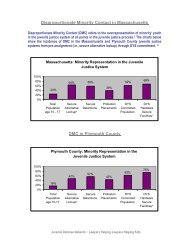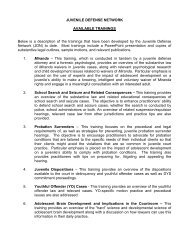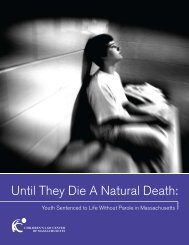Adolescent Brain Development - the Youth Advocacy Division
Adolescent Brain Development - the Youth Advocacy Division
Adolescent Brain Development - the Youth Advocacy Division
Create successful ePaper yourself
Turn your PDF publications into a flip-book with our unique Google optimized e-Paper software.
<strong>Adolescent</strong> <strong>Brain</strong> <strong>Development</strong><br />
Quick Reference Relevant Cases<br />
GRAHAM v. FLORIDA (2010)<br />
In Graham, <strong>the</strong> Supreme Court declared life without parole sentences for nonhomicide offenders under age 18<br />
unconstitutional. This decision marked <strong>the</strong> first time that <strong>the</strong> court declared a non-capital punishment to be cruel and<br />
unusual for an entire category of offenders. Although <strong>the</strong> holding of Graham arguably does not apply directly in<br />
Massachusetts, much of <strong>the</strong> language is broad enough that it can apply to juveniles who committed homicides as well as<br />
o<strong>the</strong>r offenses. Notably, <strong>the</strong>re is language indicating that life without parole sentences may not be appropriate for<br />
juveniles who “did not kill or intend to kill”, Graham v. Florida, No. 08-7412, slip. op. at 18, 560 U.S. __ (2010), as well<br />
as o<strong>the</strong>r language noting that “juvenile offenders cannot with reliability be classified among <strong>the</strong> worst offender” Id. at 17<br />
(quoting Thompson v. Oklahoma, 487 U.S. 853 (1988)) and that “[a]n offender’s age is relevant to <strong>the</strong> 8 th amendment, and<br />
criminal procedure laws that fail to take defendants’ youthfulness into account at all would be flawed.” Id. at 25. The<br />
court also noted that “[b]ecause ‘[t]he age of 18 is <strong>the</strong> point where society draws <strong>the</strong> line for many purposes between<br />
childhood and adulthood,’ those who were below that age when <strong>the</strong> offense was committed may not be sentenced to life<br />
without parole for a nonhomicide crime.” Id. at 24 (quoting Roper v. Simmons 543 U.S. at 574 (2005))<br />
ROPER v SIMMONS (2005)<br />
The March 2005 Supreme Court ruling in Roper finally outlawed <strong>the</strong> death penalty for juvenile offenders. Though <strong>the</strong><br />
majority opinion did not specifically mention recent scientific studies regarding differences between <strong>the</strong> adolescent brain<br />
and <strong>the</strong> adult brain, <strong>the</strong> American Psychological Association (APA) submitted a brief to <strong>the</strong> court in regards to <strong>the</strong> recent<br />
developments. Significantly, <strong>the</strong> scientific evidence presented by <strong>the</strong> APA was not challenged by ei<strong>the</strong>r side, something<br />
that had been done in prior decisions regarding <strong>the</strong> juvenile death penalty.<br />
ATKINS v VIRGINIA (2002)<br />
Atkins was <strong>the</strong> Supreme Court case that outlawed <strong>the</strong> death penalty for mentally retarded offenders, and set in motion <strong>the</strong><br />
ruling that was decided in Roper. Atkins is perhaps <strong>the</strong> most relevant case toward adolescent brain development<br />
specifically, as it <strong>the</strong> practice of executing mentally retarded offenders was declared unconstitutional under <strong>the</strong> Eighth<br />
Amendment (Cruel & Unusual Punishment). Justice Stevens delivered <strong>the</strong> Court’s Opinion, specifically noting that<br />
“because of [mentally retarded persons’] disabilities in areas of reasoning, judgment, and control of <strong>the</strong>ir impulses,<br />
however, <strong>the</strong>y do not act with <strong>the</strong> level of moral culpability that characterizes <strong>the</strong> most serious adult criminal conduct.”<br />
With adolescent brain development studies demonstrating that most adolescents do not fully develop <strong>the</strong> parts of <strong>the</strong> brain<br />
that deal specifically with reasoning, weighing of long-term goals, and instead tend to use <strong>the</strong> part of <strong>the</strong> brain responsible<br />
for making “gut reactions,” <strong>the</strong> Atkins case has significant implications.<br />
PATTERSON v TEXAS (2002)<br />
In <strong>the</strong> case of Patterson v Texas, <strong>the</strong> Declaration of Ruben C. Gur, Ph.D. was submitted in appeals to bolster <strong>the</strong> argument<br />
that <strong>the</strong> defendant, a juvenile at <strong>the</strong> time of <strong>the</strong> accused crime, did not have a fully developed brain, and <strong>the</strong>refore was less<br />
culpable. The decision stated in part that “<strong>the</strong> evidence is strong that <strong>the</strong> brain does not cease to mature until <strong>the</strong> early 20s<br />
in those relevant parts that govern impulsivity, judgment, planning for <strong>the</strong> future, foresight of consequences, and o<strong>the</strong>r<br />
characteristics that make people morally culpable.” Dr. Gur’s findings were reiterated in <strong>the</strong> petition for writ of certiorari.<br />
The ruling on Patterson was held however, and <strong>the</strong> accused was executed by <strong>the</strong> State of Texas in August, 2002.<br />
THOMPSON v OKLAHOMA (1988)<br />
Thompson was <strong>the</strong> Supreme Court case where <strong>the</strong> age limit for <strong>the</strong> death penalty was officially moved up to 16. Although<br />
MRI technology was unavailable to demonstrate scientific reasoning for different brain development, <strong>the</strong> Thompson case<br />
is still vital as <strong>the</strong> court differentiated <strong>the</strong> culpability of a 15-year old from that of an adult in <strong>the</strong> context of a “heinous<br />
crime.” The decision on Thompson played a critical role as precedent for <strong>the</strong> findings in Roper.

















